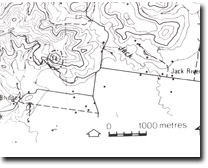14. Jack River Basalt Quarry
|
This information has been developed from the publications:
|
| Location: | 595333. 12 kilometres west of Yarram. |  Columnar jointing in Older Volcanics - Jack River Quarry. |
Access: | Boolarra Road. | |
Ownership: | Private land. | |
Geology/Geomorphology: | Basic volcanic rocks of the La Trobe Valley Group are widespread in Gippsland, and have been referred to as the Older Volcanics or Older Basalts. Outcrop samples of the Older Basalts of the Carrajung Volcanics of south-east Gippsland obtained from the quarry site at Jack River were dated by the K-Ar method as 55 million years to 57 million years old (Middle to Late Palaeocene). | |
Significance: | Regional. Prominent flow banding and sagging columnar jointing are observable in the upper part of the quarry face. The quarry site represents one of the best vertical exposures of the flow structures of the Carrajung Volcanics. | |
Management: | Maintenance of clear exposures in the quarry site would enhance the significance of the site. Although the site gives good exposures of unweathered basalt, the nature of the quarry design (i.e. cut back into the side of a steep hill) has caused large scree deposits at the base of the quarry walls which obscure readily accessible areas within the quarry. | |



